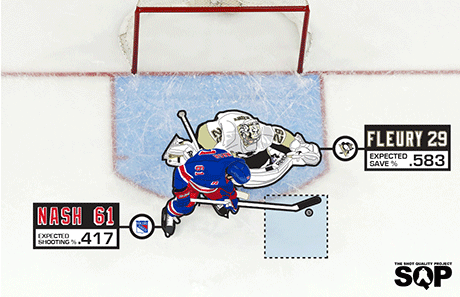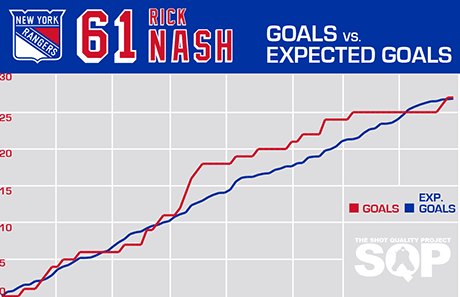It’s hard to avoid criticism during the playoffs when you aren’t scoring and you make millions per season. Fans and media are reactionary and when guys like Sidney Crosby and Rick Nash aren’t hitting the score sheet, they are immediately identified and buried. We love to measure character level and label winners and losers based on tiny pieces of information.
Jonathan Toews entered the 2014 playoffs with six goals in his previous 36 post-season games. Stories of his frustration were rampant when the Hawks almost lost to the Red Wings in 2013, but with eight goals in these playoffs, the previous three seasons of frustration disappeared. Toews has re-emerged as Captain Clutch, the true greatest player in the NHL.
The problem is slumps are generally sample-size based and when we cut them into smaller segments because of playoff years, the natural inconsistency leads to wild performance fluctuations. It is why the analytics community relies on shot metrics, because they offer a better look at a player and remove a lot of the noise.
If we look at Toews’s playoff production early in his career (2008-09 and ’09-10) and extrapolate and 82-game campaign, he is a 30-goal Conn Smythe winner. From ’10-11 through ’12-13, though, he dips to a disappointing 14-goal player. This year he’s up to 47 goals because he is shooting 26 percent. And if we look at his entire 92-game playoff sample, he is the same 25-30 goal guy he’s been over close to 500 regular-season games.
Unfortunately for Rick Nash, with an $8-million salary comes the demand of goals. It is of no interest to fans that Nash has been a fairly dominant possession player and his team is winning the battle while he is on the ice. Or that he has accomplished this while managing tough assignments during the 2014 playoffs. He isn’t scoring and this is a problem, a problem for which we are dying to define him until the narrative changes with a hot streak.
During my research, I identified that, regardless of location, if we added in slightly more context the numbers could shift. Shots preceded by passes, rebounds or pucks that are tipped shift the odds to greater success. We tend to look at the game in simple concepts. When players disappoint us by missing scoring chances too often, we often vilify them for their failure. The reality is, even on the greatest scoring chances the odds of success rarely move above 50 percent.

The shot quality project isolates areas on the ice that have higher scoring probabilities, but even the one pictured above where Nash tips a puck from the lip of the crease in front of Marc-Andre Fleury only results in a goal four of 10 times. During a playoff series, you could conceivably tip six pucks and come up empty, even though statistically you should have produced almost 2.5 goals. This is the danger of judging a small sample.
One of the things I’ve been working towards is a goal-expectancy chart. It’s still in its infant stages because I have just over 40,000 shots, but it’s accuracy will improve with a larger sample size. It’s large enough that I can get a good gauge of shot quality. So with the noise surrounding Nash, I decided to put his production to the goal-expectancy test.
I reviewed every shot Nash took during the 2013-14 season (regular season and playoffs up to Game 3 of the Canadiens series) and calculated his expected goal total. Nash has been accused of weak perimeter play, and of the 320 shots I looked at, 75 registered at 1 percent or less of scoring. These included dump-ins from the neutral zone, clean shots from just inside the blueline and shots from along the boards from an impossible angle. These type of shots create noise in our general shooting-percentage numbers and lead to explanations like luck—a divisive term with fans because it tends to take credit away from the player. “Luck” is used because it simplifies the concept instead of other terms that fans tend to reject, like probability and regression.
The more shots you produce, the more fortune you will find and if Nash continues to fire pucks from “good ice” pucks will find ways into the net. The more you are in that position, the better the odds that players will make mistakes or bounces will find their way.
I tracked his results game-by-game and charted his actual production (goals) versus his expected goal total.

There is a pretty straight progression line (in blue), a stark contrast to the streaky pattern most goal-scorers produce. Pretty much game-in and game-out, Nash creates scoring chances and drives play. That is reflected in the consistency of his expected goal total—he just isn’t consistently rewarded with goals. Marian Hossa had a brilliant response earlier in the playoffs when he condescendingly said that the difference in the perception surrounding him was the result of him scoring a goal in that night’s game. His process hasn’t changed, just the way we absorbed the result.
Nash more or less maintained a steady goal-scoring pattern until early January when his production took off with 11 goals in 15 games (in red). He maintained a consistent record of producing scoring chances, but the expected numbers trailed his actual production until he flat lined in the playoffs and his numbers dipped below expectation. He has recently begun to produce again with three goals in the first five games against Montreal.
This measured approach isn’t as fun as defining a player’s character or speculating about injuries—especially if you enjoy the teeter totter approach of that game. Nash will never escape criticism during these droughts because of the expectations that come with his pay cheque, that is the reality of the situation. But he is a 35-goal guy who played at a 30-goal pace during the season and had a regression kick in at the wrong time of year—the time of year when legacies can be defined. Fortunately for Nash, our memories are short and two or three timely goals over the next couple of weeks will give us all collective amnesia as we scramble to write a new reputation for him.
